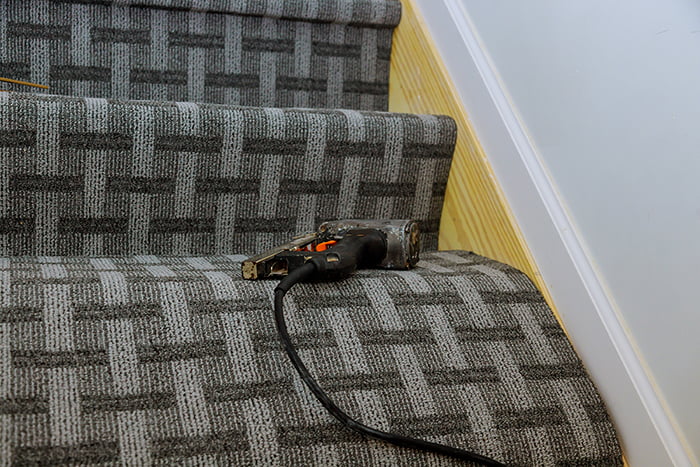Once you have torn out and cleaned up everything from your old stair carpet, it’s time to decide whether you want to fit your new one ‘the DIY way’ or hire a fitter to get the job done at an additional cost.
Many people choose to fit their stairs flooring themselves, which is why this guide takes you through 5 simple steps on how to fit carpet on your stairs.
It will help you make sure your fitting is done to perfection. That means it goes snug over each stairway tread, while using the right materials so that your new carpet will stand the test of time.
At the end we explain what changes to make if you have a staircase that turns in the middle or has a larger step toward the top or bottom.
Let’s start by listing the tools you will need.
Tools you need for fitting stairs carpet
The good thing? You don’t need any expensive machinery to do this job. Here’s the list
- Staple gun with half inch staples and quarter inch width
- Metal rule
- Utility knife
- Carpet stretcher fitting tool
- Carpet tucker
You could save money by purchasing a full carpet fitting kit, which includes the tucker, stretcher and a knife.
Step 1 – Reuse/Fit the gripper rods
You may be able to hold on to the gripper rods after removing your old flooring or you might need to replace them. For example, if they are damaged.
Either way, you will want to make sure you have strong gripper rods before fitting any carpet.
Gripper rods should be placed on either side of each tread and at the back of each tread by the base of the next step.
Read our guide here on How to fit gripper rods and underlay correctly.
Step 2 – Place one piece of underlay on each step
A good, dense underlay is vital for the protection of your carpet.
So, it will be important to choose a high density underlay, which can handle the extra foot traffic and additional thudding without wearing out your new flooring.
Start by placing a piece of underlay on the first step, on the inside of the grippers, with a bit of an overlap.
Staple it down around the edges using a hammer stapler and then cut the piece to the exact size, using the front of the tread as a straight-line-guide.
Work your way through each step, placing a piece of underlay inside the grippers and to the front edge of the tread.
TIP: Make the underlay go over the step and then cut to size (don’t try and cut the perfect size before stapling down.
See here for a full guide on how to fit carpet and underlay yourself
Step 3 – Cut and fit a length of carpet
If you need to know how to measure the stairs, have a read of our guide here
Measure out your first length of carpet. A good starting point is to do 4 steps using approx. 6.5 feet long.
Cut it with your utility knife using a metal ruler or another straight edge.
TIP: Make sure the carpet don’t get wider or thinner as you work your way up the staircase. You don’t want to be left with a gap on either side when you get to the last step.
So, start by stapling the front edge of the carpet strip to the base of the first step, making sure it is flush against the ground flooring.
Now there are a couple of options, as you take it over the tread.
- If you have the usual overhang, then you may wish to staple the carpet to the top of the base of the first step, underneath the overhang.
- Alternatively, you may wish to go straight over the edge of the step and simply attach the carpet to the griper rod at the back of the tread.
Whichever you choose, here’s how to make sure the finish is super tight against the gripper rod.
Use a fitting tool to push it against the gripper rods where the first step meets the base of the second step – forcing it into the corner of the steps.
Use your knee or a hammer for extra force and run the tucker along the top from the front of the first tread to the base of the second step.
Take your time making sure it fits snug into the stairs and perfectly fits over the edge of the stairway, while at the same time fitting right into the corners.
Step 4 Continue up the stairway with the first length of carpet
Depending on what you decided regards stapling the carpet under the overhang of the first tread or simply shaping it over the edge, you should replicate this method for the remaining steps.
When you get to the end of the first length, slice the material at the base of the step before it ends. Then dispose of the surplus material.
That means you can start the next length with a full step and hide the join underneath, at the very bottom of the base.
Of course, if your stairs are short enough for you to fit a single length, then it is recommended to only use one piece. That way you avoid the need for joins.
Step 5 Join each piece of carpet
Start the next piece of carpet in similar fashion as you did the first. Make sure the joins are lined up perfectly with the pattern of both the first and second length. It’s often slightly easier if you have a plain pattern
Again, use a tucker and a stretcher to make sure the material is flush against the steps as you work each piece of carpet, work your way up the stairs.
How do you fit stairs carpet if you have a landing or a turning (wider) step?
You will be happy to know that not much changes when fitting the carpet to the steps when you have a large step or a turn.
The most important thing is to make sure the length of material is big enough to go over the large step.
You also need to take into account the shape of the big step. Often it is wider too, be sure to cut so it is shaped in exactly the same way as the step.
However, it is always best to do the middle landing separately. That way you can guide each piece of carpet around the turns as needed.
If you are looking for more guidance on how to complete this job, read this article from DIY Doctor
So, there you have it. Fitting stairs carpet is achieved relatively easy when following the right guidelines.
We would love to hear you comments on how you get on with your project.




